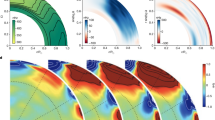Abstract
DETAILED information about near-surface ocean currents is needed for effective fisheries management, pollution mitigation, search and rescue, and climate studies, but the present generation of measurement techniques provides only limited spatial and temporal resolution or coverage1,2. In near-coastal environments, pairs of shore-based high-frequency radars have been used to map surface currents over an area of a few hundred square kilometres3,4. The potential for mapping open-ocean current fields has been demonstrated using military high-frequency radars that can be used to 'see' over the horizon for thousands of kilometres by reflecting signals off the ionosphere. But using one radar, only one current component can be mapped by this method5. Here we report the mapping of surface-current vectors obtained from simultaneously employing two such radar systems with overlapping coverage. We obtain a current map in the Florida Straits, about 1,500km from the radars, covering two 70,000km2 areas at a resolution of 10km and O.lm s–1. As it employs only about 2% of the radars' potential coverage, the test shows the potential of this technique for mapping the more energetic features of ocean circulation—such as boundary currents and mesoscale eddy systems—over vast ocean areas.
This is a preview of subscription content, access via your institution
Access options
Subscribe to this journal
Receive 51 print issues and online access
$199.00 per year
only $3.90 per issue
Buy this article
- Purchase on Springer Link
- Instant access to full article PDF
Prices may be subject to local taxes which are calculated during checkout
Similar content being viewed by others
References
Proc. IEEE Fifth Working Conference on Current Measurement (Institute of Electrical and Electronics Engineers, Piscataway, NJ, 1995).
Stewart, R. H. Satellite Oceanography 278–285 (Univ. California Press, Berkeley, CA, 1985).
Barrick, D. E., Evans, M. W. & Weber, B. Science 198, 138–144 (1977).
Hammond, T. M. et al. Continental Shelf Res. 7, 411–431 (1987).
Georges, T. M. & Harlan, J. A. Eos 76, 146 (1995).
Georges, T. M. & Harlan, J. A. IEEE Antennas and Propagation Mag. 36(4), 14–24 (1994).
Lee, T. N. et al. J. Geophys. Res. 100(C5), 8607–8620 (1995).
Author information
Authors and Affiliations
Rights and permissions
About this article
Cite this article
Georges , T., Harlan, J. & Lematta, R. Large-scale mapping of ocean surface currents with dual over-the-horizon radars. Nature 379, 434–436 (1996). https://doi.org/10.1038/379434a0
Received:
Accepted:
Issue Date:
DOI: https://doi.org/10.1038/379434a0
This article is cited by
-
North Sea hydrodynamic modelling: a review
Senckenbergiana maritima (2004)
-
Ocean currents mediate evolution in island lizards
Nature (2003)
Comments
By submitting a comment you agree to abide by our Terms and Community Guidelines. If you find something abusive or that does not comply with our terms or guidelines please flag it as inappropriate.



